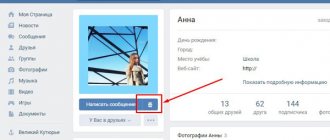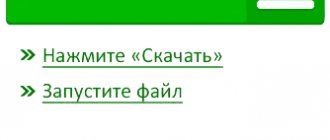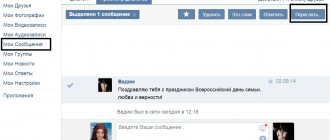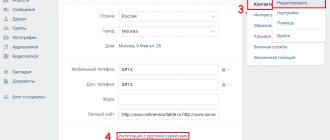Rules of the game “Contact”
- First, the driver .
- He thinks of a word (usually a noun, a common noun), which the other players must guess.
- After that, he tells the players the first letter of this word.
- Now all players take this letter as a basis and begin to come up with their own words starting with this letter. They ask the driver questions without directly naming them.
- The driver answers them with the phrase “ No, this is not (the intended word)!” "
- If the driver did not have time to answer or did not guess the intended word, the other players also try to guess it. The one of the players who decided that he guessed (let's call him the guesser ) according to the description of the word thought who came up with it , says “ CONTACT!” " and counts: " one-two-three !" after which the one who came up with it and the one who guessed must say this word together.
- If the words coincide ( “contact ” has taken place), the driver must tell them the second letter of his intended word. In this case, the players’ attempts continue, but the players think of words starting with the first two (three, etc. letters).
Naturally, as you guess the letters, the circle of possible word options narrows and in the end the word is still solved. The game continues until the players guess the word intended by the driver or until they spell it. Then the player who named the word becomes the leader and the next round of the game begins.
Let's show the game with an example:
Let’s say the driver thought of the word “ Igroteka. ” After that, he tells the players the first letter of this word: “ I. ”
What else to read: Traditional games, round dances and good fun
The person who comes up with the idea comes up with a word starting with the letter “ I ” - “ History ”, and says its description:
- Is this where they end up?
The driver cannot say anything. Then one of the players ( who guessed correctly ) decides that this is the word “ India ”. It says “ CONTACT!” " and counts: " one-two-three! ”, after which the one who came up with the idea says “ History ”, and the one who guessed “ India ”. There is no contact, play continues.
The next one who came up with it says:
- Is this a yellow bird?
To which the driver says: “ No, this is not an oriole!” "The next person to come up with a word starting with " I " - " Turkey " and says the description:
- Is this an inflating bird?
The next guesser realizes that this is Turkey . It says “ CONTACT!” " and counts: " one-two-three! ”, after which the one who came up with the idea says “ Turkey ”, and the one who guessed “ Turkey ”. The contact has taken place, and the driver gives them the second letter of his hidden word: “ G ”.
Game continues. Now players come up with words in " IG ". The next person to come up with a word on “ IG ” is “ Needle ” and says the description:
- Is this what they sew with?
The driver says: “ No, this is not a needle!” "and thereby disrupts contact. The next person to come up with a word in “ IG ” - “ Igrek ” and says the description:
- This is X's brother
The next guesser understands that this is Igrek . It says “ CONTACT!” " and counts: " one-two-three! ”, after which the one who came up with the idea says “ Igrek ”, and the one who guessed “ Igrek ”. The contact has taken place, and the driver gives them the next letter of his hidden word: “ R ”.
Again the word is guessed and so on... The roles change and all the players (except for the driver) have time to be both the one who came up with the role the one who guessed the role .
And now - tricks and tricks:
- It is better to take words for the game that are more complex and longer. Words with a deceptive beginning are very suitable, for example, “metrology”, “canine handler”, “locomotive building”
- Players, when asking questions to the driver, must come up with the most non-obvious descriptions. After all, there is only one driver, and there are several players “attacking” him. There is always a chance that among the players there will be someone who will guess before the driver;
- If adults play this game, they can cooperate on a professional basis. For example, two programmers (doctors, lawyers) will be able to quickly “contact” each other using their terms before the driver “messes up” the contact.
What else to read: Children's game "Grandma's Pantaloons": rules
Contact
First, briefly the rules of the game
The presenter thinks of a word, names its first letter (the word must be a common noun in the singular, nominative case). During the round of guessing a given word, all definitions must concern words starting with the specified letter (or, in the future, the specified sequence of letters).
Participants ask the facilitator definition questions. The presenter must come up with a word that fits the definition and answer: “no, it’s not ... (indicates the term implied by the participant),” or, if the definition clearly describes the hidden word, “yes, it’s (the hidden word).”
Since the definition usually does not limit the area to one word (an example of a question asked: “Isn’t that a bird?”), the leader does not have to guess exactly the word that the guessers have in mind - any word described by the definition is enough. Some modifications to the rules prohibit further questions without changing the definition (such as “Is that another bird?”).
If the presenter cannot come up with a suitable word, but another participant (or several) grabbed the questioner’s idea, then that participant (participants) says “contact” (implying that mental contact has occurred), time is given up to 5 minutes or a countdown begins (for example, from 10). If during the countdown the presenter still does not name the appropriate word, the “contacting” participants pronounce the words they meant in chorus. If they pronounce the same word, the leader names the first unguessed letter of the hidden word, and he is asked the definitions of nouns starting with the indicated letters. Sometimes it is necessary to match the words of only two of all those “in contact” or it is not necessary at all to pronounce a word by several participants at the same time.
The goal of the participants is to come up with words such that the presenter cannot guess what the word is, but other participants can guess. One of the possible strategies (not encouraged, however) is to guess question terms from an area in which the guessers are strong, but not the leader.
The game ends when the players pronounce out loud the word chosen by the leader. After this, the leader usually changes (for example, to the participant who asked the decisive question).
More variations...
Contact (option 1)
This version of the game appeared earlier than the second version. But the second option is more interesting! Can be played by 3 people or more. One of the players (Vasya) thinks of a word (a noun, in the singular, in the nominal case, which is not a name or title), for example “rotator” (it’s better to guess long words. The rest of the players must guess this word. Whoever guesses it will think of a word next time. Vasya tells the others the first letter: “k”, after which the players ask him questions according to the following principle. You need to remember some word starting with the letter “k” and Vasya tells him about this word. For example, the player comes up with the word “cow”, and he asks Vasya: “Is this not an animal?” Since the “rotator” is not an animal, Vasya must come up with some animal starting with the letter “k” (for example, “cat”), and answer: “No, this is not a cat." This has exhausted the question about the animal, and you can no longer ask it. You can, however, clarify the question and ask: “Is this not an animal other than a cat?” Vasya can answer in response: “No, this is not a rat.” Etc. However, to the question “Is this not a tool?” Vasya should answer: “Yes, it is a tool.” Then he may be asked: “A rotator?” Vasya will say yes, and the game ends there. But, let’s say, no one has guessed this yet, but Vasya was asked, “Isn’t this a kind of museum?”, meaning the word “Kunstkamera.” Vasya says: “No, this is not...” and thinks for a long time, because this word flew out of his head. In this case, if another player remembers the word “Kunstkamera” or some other type of museum starting with the letter “k,” then he says: “Contact!” Before the start of the game, it is agreed upon, depending on the number of players, how many contacts will play. For example, they agree to play up to two contacts. This means that if Vasya was asked a question, and two contacts were made before Vasya had time to answer, then these three players say their words at the same time, and if these are indeed words that satisfy the necessary conditions (but not necessarily the same), then Vasya should name the next letter (“o”). Thus, the players already know the beginning of “ko”, and all questions should now be asked about words that no longer begin with “k”, but with “ko”. You can also agree in advance that if there was only one contact, then if after one minute from the moment of contact Vasya did not come up with a word, then he also names the next letter. The game continues in this way until all the letters are guessed one by one, or the word is guessed.
Contact (option 2)
If you don’t know how to play contact at all, then read the rules of the first option first, and then read this option. In the same way, Vasya thinks of a word (“rotator”), and tells the first letter: “k”, after which (unlike the first option) the players do not ask him questions about the words, but give hints to each other about these words. For example, the word “cow” comes to Petya’s mind, and he says a hint out loud: “It’s so butting.” Vasya thinks and says: “Cow.” The hint is over. Now, let’s say the word “sausage” comes to Petya’s mind, and he hints: “It’s so delicious.” Vasya says: “Candy.” Petya says: “No.” Vasya thinks further, and then Gena also comes up with a tasty treat starting with the letter “k”. He does not say the word “contact”, but instead immediately begins to slowly (but not too slowly) count out loud to ten. If during the counting Vasya manages to come up with the correct option and say it, then he is lucky. And if Vasya does not say the correct word, then, after counting to ten (at the count of 11), Gena and Petya simultaneously say their own word. If these words match, then Vasya will have to say the next letter, and if they don’t match, then nothing happens. It may turn out that no one can figure out what kind of yummy thing starting with the letter “k” is. Then Petya can make more hints about the same word. For example: “It’s long,” “They sell it in stores,” or “It’s made from meat.” It may turn out that someone accidentally comes up with the correct word. Let’s say Gena also comes up with the word “twist,” and he says a hint: “They turn it.” Vasya must answer: “Yes, they are playing with it.” “Rotator?” "Yes". The word has been guessed.
One of the players thinks of a word and says what letter it begins with. Everyone else must guess the word. For example, the presenter says that the word begins with the letter “l”. In order for the presenter to open the second letter, it is necessary to select a word starting with the letter “l” and give it a short description. For example, one of the players says: “It is in the sky at night.” Whoever guessed it says “contact” and together with the player who gave the characteristic, count to 10 and name the word. If the words turn out to be different, then the players continue to select words starting with the letter “l”. If the words match, then the presenter calls the next letter, for example the letter “a” and then the syllable “la” is formed. Now they begin to select words for this syllable, characterize them, count to 10, etc. The presenter can also guess the words that the participants characterize. If he guesses right, then he will have to choose new words. In this game, it is important for the leader that his word cannot be guessed for as long as possible.
The presenter thinks of a word (necessarily a noun) and names the first letter of this word. The players must guess the word. To do this, they remember words starting with the named letter and ask the leader one by one questions. For example, the presenter named the letter “Р”, thinking that someone remembered the word “lynx”, then, without saying the word out loud, he asks the presenter a question: “Isn’t this an animal?”. The presenter remembers the animal at <P> and, if he remembers, then gives the answer: “No, it’s not a wolverine.” After which another player asks him a question. But if the presenter cannot remember the animal on <P>, and one of the players besides the author of the question remembered, then he says: <There is contact>. Two players count to 5 in unison and say the word out loud. If together they named “Lynx”, until the presenter gives the answer, the presenter must name the second letter of the hidden word. The game continues until the word is solved.
The presenter thinks of a word and says its first letter. The goal of the other participants is to unravel the word in the following way: any word is selected for the first letter of the word and its definition, description (sometimes association) is given, without pronouncing the word itself, so that the leader does not guess, but at least one of the other participants guesses! Anyone who guesses what word is being talked about must say: “Contact!” after which he and the person choosing the word must simultaneously count to 5 (10) and simultaneously pronounce this word out loud. If it was about the same word, then the presenter reveals the next letter in the hidden word. If during the count the leader gives a version of the word that people have contacted, then a new definition and a new count must be given. The one who solves the word becomes the leader.
Logic game for guessing words. The good thing about the game is that it doesn’t require any accessories, because... everything goes smoothly, and you can play anywhere.
The presenter thinks of a word. The goal of the others is to guess the word. All players painfully come up with a test word. When someone comes up with an idea, they give a vague definition of their idea. For example: “Isn’t that an Australian animal?”, referring to the platypus. Another guesser, thinking of a kangaroo, says “Contact!” and begins to count down 10 seconds, at the end of which they both simultaneously say their words. And if they coincide, i.e. thought about the same thing, then the leader says the first letter of the hidden word.
But the presenter has a chance to break the established contact. While the 10 seconds are counting down, he aloud goes through all the animals that come to his mind, saying: “This is not an echidna! (giraffe, anteater)." If the presenter is wrong in his assumption, the countdown continues; if he guesses what the person who said “Contact!” meant, then the connection is broken and the next concept must be thought about. When the first letter is guessed, the guess words should begin with it; when there are two letters, the number of possible words decreases even more, etc. If you wish, you can not try to establish “Contact”, but simply ask the person guessing about some word. But this is not the best way, because there are only 2 options - you guessed right/you didn’t guess right, and you won’t receive any additional information, as in the case of a contact. After all, the presenter may not even guess about the word when there is a 10-second countdown.
To explain this chaotic description of the rules, give an approximate version of the game process.
Riddled: TREE.
Player 1: Isn't this a dough product? (Referring to a bagel) Host: This is not a loaf. 1: Not that! Q: This is not a pie. 1: No. Player 2: Contact! (thinking, for example, about pasta) 10, 9, 8... Q: This is not a bun. 1: Not that again. 2: 7, 6, 5, 4... Q: These are not cookies. 1: No. 2: 3, 2, 1. 1 and 2, together: Bagel/pasta!
There was no contact, the leader does not speak the letter.
1: Isn’t this something you can write with? Q: This is not a pen, pencil or marker. (versions before “Contact” can be issued) 1: No. Q: This is not ink. 1: That's right.. 1: Isn't this a lot of musical instruments playing at the same time? 2: Contact! 10, 9, 8.. The presenter is in a stupor. Contact, and their word “Concert” is the first letter “D”, says the presenter. 1: Isn't this someone's special sword? The presenter has one thought - Excalibur, but this is not the topic, because it does not start with the letter D. The 2nd player made contact and guessed the thought of the first one, that this is the Sword of Damocles. Q: The first two letters are DE 2: Isn’t this money? B: No. 1: Isn't this a small settlement? (village) Contact, and the leader says the third letter R. DER 1: Is this a tree? B: Yes!
Q: This is not a pen, pencil or marker. (versions before “Contact” can be issued) 1: No. Q: This is not ink. 1: That's right.. 1: Isn't this a lot of musical instruments playing at the same time? 2: Contact! 10, 9, 8.. The presenter is in a stupor. Contact, and their word “Concert” is the first letter “D”, says the presenter. 1: Isn't this someone's special sword? The presenter has one thought - Excalibur, but this is not the topic, because it does not start with the letter D. The 2nd player made contact and guessed the thought of the first one, that this is the Sword of Damocles. Q: The first two letters are DE 2: Isn’t this money? B: No. 1: Isn't this a small settlement? (village) Contact, and the leader says the third letter R. DER 1: Is this a tree? B: Yes!
Of course, more than 2 guessers can take part in the game, but it is impossible to establish 2 or more contacts at the same time - it is difficult for the leader to work on two fronts, and it is not sporting.
One person (water) thinks of a word and tells everyone only the first letter, the rest must guess. If someone comes up with a word starting with this letter, he must ask (for example, the letter was “a”) the water something like: “but this is not bird?" or “isn’t this a pond for fish?” you can simply ask “is this not watercolor?” then he can immediately answer yes or no. Then if one of the remaining people guesses what that person was thinking about, he says “contact” and the water has about a minute or 30 seconds to guess the word they meant. If he guesses and he says, then you can repeat the question 2 more times (they are only 3 times one question) and if he always manages to answer this question, then you can’t push him anymore. (Isn’t this a bird? No, this is not a stork. Is this not a bird? no it’s not an albatross...)
If water didn’t guess and he ran out of time, then all those who said “contact” must say the word they thought one, two or three times, and if at least two of them match, then water must open the next letter... and so on until the end
The driver thinks of a word and names its first letter. You can only guess singular nouns, nominative case, that are not proper names. Then the players make assumptions about what this might be and hint at this to everyone, including the driver. If the driver guesses what is meant by the question, he answers whether the word was guessed correctly, and if not, one of the players makes the next guess and the next hint. If the driver cannot guess, but several other players guess, then each of those who guessed says: “Contact!!!”, and they all, together with the one who guessed, count loudly to ten, giving the driver time to figure it out, then call out the word in chorus. If they all name the same word, which the driver never thought of, the driver names the second letter and so on. Below is an example of a game conversation:
Driver: - I thought of a word starting with the letter T. One of the players: - Maybe this is an agricultural machine? Driver: - No, this is not a tractor. Another player: - Maybe this is a small expensive public transport? The driver thinks. The first player guesses what is going on. First: - Contact!!! Both: - One, two, three, four, five, six, seven, eight, nine, ten! Taxi!!! Driver: - Second letter A. First: - Maybe this is a combat vehicle on tracks? Driver: - Yes, this is a tank. The first one becomes the driver.
Purpose of the game: Guess the word Rules: One player guesses a word and names its first letter. The rest must guess this word by asking questions about words starting with this letter. The responder must give an answer that satisfies the person asking the question, that is, guess his word. If he doesn’t guess, he must name the second letter of the word and everything is repeated, only now the players ask questions about words starting with a known combination, etc. Whoever guesses the word now guesses a new one. Notes You can play while walking on a hike.
The rules are very simple: One of the players thinks of a word and says what letter it begins with. Everyone else must figure it out. EXAMPLE: The presenter says that the word begins with the letter “M”. In order for the presenter to open the second letter, it is necessary to select a word starting with the letter “M” and give it a short description. For example, one of the players says: “This is in a person’s head.” Whoever guessed it says “contact” and together with the player who gave the characteristic, count to 10 and name the word. If the words match, then the presenter calls the next letter, for example “U” and then the syllable “MU” is formed. Now the players begin to select a word starting with the syllable “MU”. The presenter can also guess the words that the participants describe. If he guesses right, then the players will have to choose a new word. In this game, it is important for the leader that his word cannot be guessed for as long as possible.
Rules: the whole team plays. The presenter thinks of a word and tells everyone its first letter. The team's task is to guess this word.
They guess like this. Any team member asks the leader a question like: “Isn’t this...”? For example, if the first is “A”: “Isn’t this a big round one with red inside?” assuming it is "watermelon".
If the presenter wishes for a watermelon, then he says that the word has been guessed, and the right to play the game goes to the person who guessed it.
If this is not a Watermelon, and the presenter guesses from the question what he is being asked about, then he says: “No, this is not a watermelon” and the players continue to ask questions.
If the presenter did not guess from the question what he was being asked about, but one of the players guessed, then that player says “Contact.” After this, the presenter is given two or three minutes to guess what word the “contacted” players are thinking about. If there are no guesses, then at the leader’s expense “one, two, three,” the players who asked the question and said “Contact” must simultaneously say the word they guess in unison. If both said “watermelon,” then the presenter “reveals” the second letter of his word to everyone and the players again ask questions and guess.
If they said different words, then the players' questions continue. And so on until the word is guessed.
The driver thinks of a word and tells the others the first letter. The rest come up with words starting with this letter and ask the driver a question about the invented word (“Isn’t this ...?”). The driver must answer the question posed. If someone other than the player who asked the question knows the answer, he says the word “Contact” and begins to count out loud to ten together with the player who asked the question. On the count of ten, they must say a word at the same time. If both players have the same words, then the driver says the second letter of the hidden word and the following questions will be asked by the players about words starting with these two letters. If the driver manages to name the word before the players count to ten, then they come up with new words. One question can be asked no more than three times. For example, the driver thought of the word “Adjika” and told the others the letter “A”. Player 1 asks: “Is this not a fruit?”, The driver answers: “This is not an orange.” Player 1 again asks: “Is this not a fruit?” The driver replies: “This is not a pineapple.” Player 1 again asks: “Is this not a fruit?”, The driver answers: “This is not an apricot.” Now the question is “Isn’t this a fruit?” You can't ask anymore. Then player 1 asks: “Isn’t this the place where all the animals are sick?” While the driver is pushing, player two shouts: “Contact” and together with the first one count to ten. On the count of “Ten” they shout “Africa” and the driver tells them the second letter: “D”. Now you need to ask questions: “Isn’t this what is released into the blood when you are stressed?” (Adrenaline), “Isn’t that a military rank?” (Admiral)… So until the word is guessed. Whoever guessed right is the new driver.
“Contact” Oral verbal game number of players from 3 to 15 people age of players from 6 years time for the game from 20 minutes time to explain the rules 2-3 minutes no props needed You can play along the way.
Rules of the game.
Several people play. The leader thinks of a word and tells the others the first letter of this word. All other players try to guess this word by asking the leader questions. At the same time, they name the definitions of any words starting with this letter. The definitions must be clear to at least one other player. The presenter must quickly understand what the players have said - or come up with his own version of a word starting with this letter that matches the stated definition. If one of the players says a definition, then the rest should try to understand what he means, and, if they have an answer, say “Contact!” After this, the presenter must come up with his own answer in a minute - otherwise he says: “I give up!” Then those who had “contact” say their options out loud. If at least one of these options coincides with what the author of the definition had in mind, then the presenter must say the next letter of his word. After that, everyone comes up with definitions of words starting with these two letters - and so on until the entire word is guessed. The one who first names the hidden word becomes the leader and guesses the next word.
EXAMPLE: The word “pipe” is guessed. The presenter reports the first letter - “C”.
- Isn't this some kind of pet? - asks A.
- Contact! - says player B.
- No, it's not a pig! - the presenter answers.
- Isn't this something they give small children to suck on? - asks player B.
- Contact! - say players A and D. This means they understood player B’s explanation, and can say the answer out loud after counting 10.
- No, it's not a pacifier! - says the presenter. He “fighted back” - he remembered the right word that fit the definition.
- Isn't this a tree? - asks player G.
- Contact! - say players A, B.
- No, it's not pine!
- Is this such a big stone? - asks player A.
- Contact - says player B.
- I give up!
- Rock! — B.
- A rock - why not a rock?! - Player A explains his logic. If no one understood his explanation, he would have to reformulate his question. If there is “Contact”, it means that the definition was given well.
If the player who guessed the word could not guess, then he gives out the next letter of the guessed word.
- Okay, then "SV".
- Isn't this the opposite of darkness?
- Contact.
- No, it's not light.
- Isn't this the one who comes to the bride?
- Contact.
The players count to 10 in chorus, then call out their versions in chorus. If the versions do not match, then the driver may not say the next letter - there was no contact!
- Matchmaker!
- Well then, “SVI”.
- Isn't this thick and dirty?
- Contact!
- No, it's not a pig!
- Isn't this so thick and warm?
- Contact.
- I give up!
- Sweater!
- Okay, SVIR.
- Oh, I don’t even know those words!
- Isn't this a musical instrument?
- Yes, it's a pipe. Think about the word!
The next driver is the player who came up with the last successful definition and guessed the word.
Links
- Wikipedia
Promoting the process of the game “There is a contact”
- The next player in turn offers his own version of the word starting with the first two letters.
- For example, "Mill". But he, of course, does not pronounce the word itself, but tries to explain it in other words.
- He says: “This is what they grind wheat and make flour.” The presenter, in case of a guess, says: “No, not a mill.”
- If he hesitates or does not come up with an answer, then any of the participants who guessed the meaning of this word says: “There is contact,” then counts to three.
- Both participants - the one who proposed the word and the one who guessed its meaning - must simultaneously say the word out loud.
- Coincidence? This means that the presenter pronounces the third letter of his intended word.
- Didn't match? The next player offers his option.
- So, letter by letter the word must be guessed.
- The entire word can be guessed. The one who guesses it becomes the leader and guesses his word.
- The game ends after a round in which one player scores 25 or more points.
- Whoever has more points wins.
The idea is the main thing
If you want to create a game on a social network, you must first of all come up with an idea. The concept of an entertainment product is the basis for the success of a future project. How exciting and unusual the game will be directly affects its distribution among VK users.
Here you don’t have to worry about the technical implementation of the gameplay, the visual design of levels, heroes, and so on. Having a good idea will help you find investors willing to invest in the project. And having received the required amount, hiring smart developers will not be difficult.
It is important to imagine yourself in the player’s place and try to offer him something new, unlike anything he has seen before. It is the fresh concept that is the most important element of the future game.
If you want to implement the project yourself, you will need extensive knowledge in programming languages: HTML, CSS, JavaScript, Adobe Flash, Action Script. It takes years to learn just a few items from the list, so it is still recommended to work as a team when creating a game. A successful product will be able to more than recoup all the financial resources spent, the effort and time invested.
Tips and subtleties of the word game “There is contact”
- Choose words that are known to everyone present.
- If the age of the participants allows, then you need to think of long words with a polysemantic beginning, for example: woodworking, mechanical engineering, reboot, etc.
- You can only guess common nouns in the singular.
- At a corporate party or among students of the same faculty, you can use professional terms and names.
- The presenter’s task is to prevent the participants from establishing “Contact” and guessing for themselves what the other players want to offer. His goal is to avoid giving them the letters of the intended word for as long as possible.
- In order to confuse the presenter and prevent him from answering first, thereby knocking down contacts, you need to come up with more complex and non-obvious descriptions of objects.
What else to read: Hide and seek is a healthy game for children's health
Sources:
- https://bosichkom.com/%D0%B8%D0%B3%D1%80%D1%8B-%D0%B4%D0%BB%D1%8F-%D0%B4%D0%B5%D1%82 %D0%B5%D0%B9/%D0%BA%D0%BE%D0%BD%D1%82%D0%B0%D0%BA%D1%82
- https://inteltoys.ru/articles/cat4/article657.html
- https://iigry.ru/slovesnaya-igra-dlya-detej-i-vzroslyh-est-kontakt/
- https://www.mosigra.ru/Face/Show/linq/rules/
- https://summoning.ru/games/lingual-games.shtml
The first stage in creating a game
When starting to implement your idea, the first thing you need to do is familiarize yourself with the section of the social network, which is intended for developers. It is located at: https://vk.com/dev.
Once on the main page of the section, you need to select the “Embeddable application” item, located in the “Getting Started” block. The page that opens provides basic concepts regarding working with embedded applications and provides documentation on various areas of development. If you want to add your game to the site, you will need to use one of the available approaches:
We recommend: Why games don’t work on VK
- iFrame – involves placing game files on third-party resources. Display in VK will be carried out in the form of a frame. Applications added using this method are available at the link https://vk.com/apps, as well as on community pages, regardless of the device used to visit.
- Flash – involves uploading game files to the VK server. They must be submitted in "SWF" format. Access to such applications is possible only through the https://vk.com/apps section.
From the “Documentation” block, the guide to creating VK games deserves special attention. It describes the platforms used to create entertainment products for the browser and mobile device. Information is also provided on user interaction and the use of some basic functions of the social network.
Game Decoding
“Deciphering” is a very fun game that allows you to unleash your full creative potential and make your interlocutor laugh. It consists of the first partner offering a random set of 2-4 letters, and the second partner guessing the meaning of the abbreviation. Here's an example:
He: PLOR.
She: Polar Glacier Bandit Society.
She: LMGP.
He: Leningrad Municipal City Monument.
He: RAVSH.
She: Russian Atomic Off-Road Highway.
Game Two Words
This is a game for smart people. Here you need not only to come up with pairs of words with opposite meanings, but also to make a choice in favor of one word, be sure to explain your choice. With arguments! Let's show with an example:
Him: Airplane, helicopter.
She: On an airplane you can fly comfortably and quickly to a distant country, without shaking and terrible noise.
She: Cutlet soup.
Him: Cutlets. The cutlets contain a lot of meat, and the protein is good for men.











